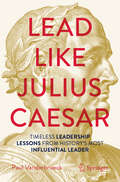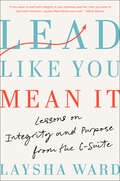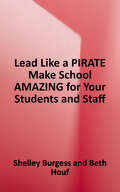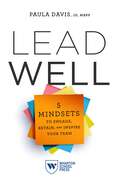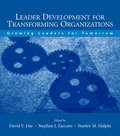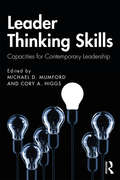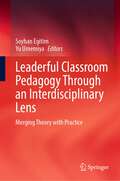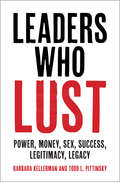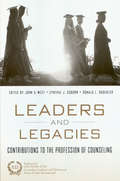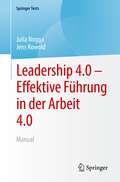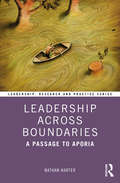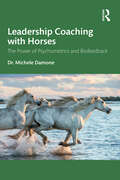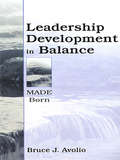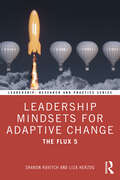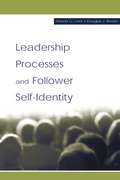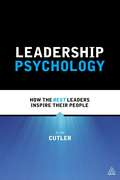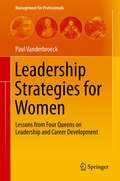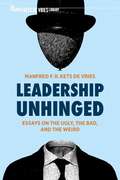- Table View
- List View
Lead Like Julius Caesar: Timeless Leadership Lessons from History's Most Influential Leader
by Paul VanderbroeckDiscover the legendary life and career of Julius Caesar in this insightful and thought-provoking book that breaks down the bold strategies, leadership skills, and motivations behind his rise to power. Beyond his triumphs, the book examines the cautionary tale of his downfall, offering timeless lessons for managers, leaders, and business students to reflect on and benchmark their careers. Through a modern lens – by applying leadership theories – this book explores Caesar's personal traits, relationships, and decisions that shaped his leadership, providing insights into his competencies and the factors behind his meteoric rise. It's a valuable case study for organizations aiming to develop strong leaders and teams, making it a must-read for history enthusiasts, professionals, and anyone seeking practical strategies for success. For managers, leaders, professionals, and business students alike, this book offers a unique opportunity to reflect on their careers and benchmark their success and ambition against one of the greatest leaders of all time.
Lead Like You Mean It: Lessons on Integrity and Purpose from the C-Suite
by Laysha WardAS SEEN ON THE TODAY SHOWA groundbreaking, inspiring, and holistic new approach to leadership from one of the top woman C-suite executives in the nationAN OPEN FIELD PUBLICATION FROM MARIA SHRIVERWe all want a healthy and happy personal life, financial security, and to do meaningful work. We don&’t want to lose sight of our values and, in pursuit of financial security and career success, get sucked into a dead-end job. We want a life filled with purpose and to leave behind a meaningful legacy. But how do we do all these things, especially in today&’s divisive times?In Lead Like You Mean It, Laysha Ward draws on her storied career as one of the nation&’s top Black female C-suite executives to show readers the answer: leading with meaning.Leading with meaning entails viewing your life and career as part of the same puzzle, acting from your purpose, making intentional choices, nurturing relationships, and championing and sustaining yourself and others. When you lead with meaning, you are taking a holistic approach that blends your life and career. You are part of something that&’s bigger than yourself, staying aligned with your purpose no matter what life throws at you or how your purpose evolves. You are stepping into, rather than shying away from, new relationships, even with people from completely different backgrounds. And you are committing to bettering yourself and being of service to others.As you learn to focus on self-care and total well-being, navigate the highs and lows of life and career, and shape a legacy that leaves people and things better off than you found them, you&’ll discover that leading with meaning—at any age—is the key to a well-lived life.
Lead Like a Pirate: Make School Amazing for Your Students and Staff
by Shelley Burgess Beth HoufAre You a Treasure Seeker? Pirates are on a constant quest for riches, but PIRATE Leaders seek even greater rewards: amazing schools, engaged students, and empowered educators who know they are making a difference. <P><P>In Lead Like a PIRATE, education leaders Shelley Burgess and Beth Houf map out the character traits necessary to captain a school or district. You'll learn where to find the treasure that's already in your classrooms and schools—and how to bring out the very best in your educators. - What does it take to be a PIRATE Leader? - Passion--both professional and personal - A willingness to Immerse yourself in your work - Good Rapport with your staff, students, and community - The courage to Ask questions and Analyze what is and isn't working - The determination to seek positive Transformation - And the kind of Enthusiasm that gets others excited about education <P><P>The ultimate goal for any education leader is to create schools and districts where students and staff are knocking down the doors to get in rather than out. This book will equip and encourage you to be relentless in your quest to make school amazing for your students, staff, parents, and communities. Are you ready to set sail?
Lead Well: 5 Mindsets to Engage, Retain, and Inspire Your Team
by Paula DavisA holistic, research-backed framework to future-proof your leadership and unlock the full potential of your teamIn the wake of the pandemic and on the cusp of the generative AI revolution, the world of work has undergone a seismic shift. Chronic stress, burnout, and employee disengagement have reached crisis levels, and leaders are struggling to keep their teams motivated and inspired amid relentless change and uncertainty. Conventional management approaches are no longer sufficient, demanding a new leadership framework to address the root causes of these challenges.To meet this moment, Lead Well: 5 Mindsets to Engage, Retain, and Inspire Your Team provides a timely and practical blueprint for a new era of leadership. Drawing on extensive research and workshops with thousands of leaders, Paula Davis, CEO and founder of the Stress & Resilience Institute and author of Beating Burnout at Work, offers a transformative approach to building high-performing teams that can adapt and grow, even in the face of relentless change.Lead Well offers actionable tools and insights to help you and your team today:+ Discover the 5 Lead Well mindsets that can transform your team’s well-being at work;+ Explore research-backed strategies to foster a greater sense of purpose, meaning, and values alignment at work;+ Gain techniques to improve workload management, work-life integration, and sustainable productivity;+ Develop skills to build team cohesion and a culture of trust and support;+ Cultivate practices that boost systemic resilience and help teams adapt to disruption; and+ Implement Tiny Noticeable Things (TNTs) that can be quickly adopted by teams.Davis’s first book, Beating Burnout at Work, addressed individuals and teams experiencing significant stress. This new book offers a method for addressing the factors that can lead to counterproductive stress and disengagement.Whether you’re a seasoned leader or an emerging manager, Lead Well provides a holistic, research-backed framework to future-proof your leadership and unlock the full potential of your team. Navigating today’s turbulent work landscape has never been more critical—or more achievable.
Leader Development for Transforming Organizations: Growing Leaders for Tomorrow (Applied Psychology Series)
by David V. Day Stephen J. Zaccaro Stanley M. HalpinThis book examines numerous topic areas that are considered to be especially relevant for making a strategic leader development investment. The topics covered are areas that have theoretical and empirical connections to important aspects of growth, change, adult development, and underlying abilities, skills, and competencies needed to lead effectively in times of great complexity. In addition, these are investment areas identified by the U.S. Army--a world-class organization faced with the need for radical transformation--as particularly relevant for success and survival. This book identifies key concerns in developing leaders and leadership, and in transforming organizations to better meet the challenges of a complex world.There are two aspects of this book that distinguish it from the numerous existing volumes on leadership in the scholarly and popular-press literatures. Most important, the overarching focus of the present book is on development. There are many offerings on the topic of leadership, but relatively few that focus on leader development--especially from a scholarly, academic perspective. Also, this volume offers a unique perspective in examining those underlying psychological competencies and processes that are viewed as especially relevant for leader development.The chapters that are collected in this edited volume were originally commissioned by the U.S. Army Research Institute as "white papers" to better help Army officers and researchers understand important issues in leader development. The present organization of the papers is around four central themes: a) Accelerating Leader Development, b) Cognitive Skills Development, c) Developing Practical and Emotional Intelligence, and d) Enhancing Team Skills.
Leader Interpersonal and Influence Skills: The Soft Skills of Leadership (ISSN)
by Ronald E. RiggioThis edited volume explores different models, conceptualizations, and measures of leader interpersonal and influence "soft skills" that are so necessary for effective leadership. These include the communication skills, persuasion skills, political savvy, and emotional abilities used by leaders to inspire, motivate, and move followers toward the accomplishment of goals. The book emanates from the two-day-long 21st Kravis-de Roulet leadership conference, which brought together top scholars working in this area. The intent of the conference and this edited volume is to increase understanding of the interpersonal and influence skills, or "soft skills," of the leader, to highlight state-of-the-art research on the topic, and to provide clear, research-based guidelines for the development of leader skills.Chapter authors are recognized experts in their respective areas, and each section of the book will be introduced by an editor-authored chapter reviewing the specific topic area in brief.
Leader Interpersonal and Influence Skills: The Soft Skills of Leadership (Leadership: Research and Practice)
by Ronald E. Riggio Sherylle J. TanThis edited volume explores different models, conceptualizations, and measures of leader interpersonal and influence "soft skills" that are so necessary for effective leadership. These include the communication skills, persuasion skills, political savvy, and emotional abilities used by leaders to inspire, motivate, and move followers toward the accomplishment of goals. The book emanates from the two-day-long 21st Kravis-de Roulet leadership conference, which brought together top scholars working in this area. The intent of the conference and this edited volume is to increase understanding of the interpersonal and influence skills, or "soft skills," of the leader, to highlight state-of-the-art research on the topic, and to provide clear, research-based guidelines for the development of leader skills.Chapter authors are recognized experts in their respective areas, and each section of the book will be introduced by an editor-authored chapter reviewing the specific topic area in brief.
Leader Thinking Skills: Capacities for Contemporary Leadership
by Michael D. Mumford Cory A. HiggsThis book examines the various thinking skills that leaders may need to find success in contemporary organizations and institutions, covering a wide array of skills that are held to be important by key leadership scholars. Bridging theory and practice, chapters summarize major findings with respect to a particular ability, knowledge, or skill, providing theoretical frameworks for understanding how these contribute to leader emergence and performance, and considering implications for leader selection, assessment, and development. The text appraises the existing research on the critical cognitive capabilities that underlie leader problem-solving and implications for the assessment and development of leadership potential in real-world settings. The role of creative thinking skills on leader performance is also addressed, bearing on the importance of processes such as problem definition and idea generation, but also using constraints to potentially stimulate creative thought. With contributions from some of the most eminent scholars working in the field of leadership, this book will be in invaluable resource to academics, researchers, graduate students, and professionals interested in leadership and leader skills, I/O psychology, and business management.
Leaderful Classroom Pedagogy Through an Interdisciplinary Lens: Merging Theory with Practice
by Soyhan Egitim Yu UmemiyaThis book focuses on the impact of teachers’ leadership identity on their pedagogical and class management choices and proposes a new pedagogical framework, leaderful classroom practices which emerged through collective, concurrent, collaborative, and compassionate interactions between the teacher and students. The interdisciplinary aspect of the book appeals to a wide range of readers from different disciplines and gives readers the opportunity to take a moment and reflect on their leadership identity, recognize the limitations of their practices, and adopt a leaderful pedagogy in their respective disciplines. Establishing an open, democratic, and participatory learning environment for all learners is a major leadership responsibility of teachers, and this book demonstrates how to accomplish this mission both in theory and practice.
Leaders Who Lust: Power, Money, Sex, Success, Legitimacy, Legacy
by Barbara Kellerman Todd L. PittinskyAmong our greatest leaders are those driven by impulses they cannot completely control - by lust. Lust is not, however, an abstraction, it has definition. Definition that, given the impact of leaders who lust, is essential to extract. This book identifies six types of lust with which leaders are linked: 1. Power: the ceaseless craving to control. 2. Money: the limitless desire to accrue great wealth. 3. Sex: the constant hunt for sexual gratification. 4. Success: the unstoppable need to achieve. 5. Legitimacy: the tireless claim to identity and equity. 6. Legacy: the endless quest to leave a permanent imprint. Each of the core chapters focuses on different lusts and features a cast of characters who bring lust to life. In the real world leaders who lust can and often do have an enduring impact. This book therefore is counterintuitive - it focuses not on moderation, but on immoderation.
Leaders and Legacies: Contributions to the Profession of Counseling
by John West Don Bubenzer Cynthia OsbornLeaders and Legacies discusses leadership involvements in the historical development of the profession of counseling. The lives of 23 noteworthy counselors are also chronicled, documenting their dreams, work and accomplishments.
Leaders in Transition: The Tensions at Work as New Leaders Take Charge
by Richard Elsner Gilles AmadoLeaders in Transition brings a new perspective on why some leaders succeed more than others when taking charge of an organisation. Based on in-depth case studies, when four new leaders and their teams in large and complex international organisations were tracked for over a year, this book uncovers that success in managing transition is directly related to leaders' ability to balance tensions, appropriately to the context. The reasons for each leader's effectiveness are explored and analysed, allowing the authors then to extrapolate some general conclusions about the ways in which these tensions reveal themselves during all leadership transitions. Evidently, the success or failure of a new leader is the result of the way multiple actors (the new leader, his or her boss, his organisation and its stakeholders) behave, before and during the taking charge. These multiple interactions are revealed and discussed.
Leadership - What Really Matters: A Handbook on Systemic Leadership
by Daniel F. PinnowWhat does really matter for daily leadership? How would a good and effective manager be characterized? Daniel F. Pinnow describes in a very illustrative way the essentials of collaborating with people in the business environment. This standard reference book exists as a 4th edition in German and is also available in Chinese. It provides a comprehensive and easy-to-understand overview over the most important leadership approaches in theory and practice. The credo of the author is: Leadership is an art of creating a world where others would love to join in.
Leadership 4.0 – Effektive Führung in der Arbeit 4.0: Manual (SpringerTests)
by Jens Rowold Julia NoggaWie können Führungskräfte in der digitalen Arbeitswelt ihre Mitarbeitenden bzw. Arbeitsteams motivieren und an die Organisation binden? Welche führungsbezogenen Verhaltensweisen sind dabei unverzichtbar? Welche Instrumente können Personaler*innen nutzen, um Führungskräfte auf die neuen Herausforderungen der Arbeitswelt 4.0 vorzubereiten? Hier erhalten Sie den ersten Fragebogen der Führungsverhalten in digitaler Umgebung messen kann.Wie von der Praxis benötigt, kombiniert dieses Modell eine Vielzahl effektiver Verhaltensweisen, woraus ein neuer Führungsstil entsteht. Dieser beinhaltet dabei vier Facetten von Verhaltensweisen, die nachgewiesenermaßen relevant für den Erfolg von Führungskräften und ihre jeweilige Organisation sind.Dazu zählen:a) die Partizipationb) die Arbeitsgestaltung (räumliche, zeitliche und technologisch)c) die individuelle Entwicklungd) die TeamentwicklungDie vier Facetten von bilden eine angemessene Grundlage, aktuelle Aufgaben und Probleme der organisationalen Praxis zu bewältigen. Durch die veränderten Arbeitsbedingungen der Arbeit 4.0 ergeben sich zahlreiche Herausforderungen, mit denen Führungskräfte in Unternehmen konfrontiert sind. Die Grenzen zwischen Erwerbsarbeit und privatem Freizeitbereich verwischen zunehmend, sodass Mitarbeitende einerseits mehr Partizipation, andererseits mehr subjektiv erlebte Relevanz in ihrem Job erleben möchten. Deswegen müssen Führungskräfte ihren Mitarbeitenden die Möglichkeit geben, sich an Entscheidungen im Unternehmen zu beteiligen. Dies kann erfolgen, indem Führungskräfte ihren Mitarbeitenden ermöglichen, Einfluss auf Arbeitsinhalte zu nehmen oder Prozessinnovationen anzustoßen.Da ein Fachkräftemangel auf dem Arbeitsmarkt herrscht, steigt die Bedeutung, kompetente Mitarbeitende im Unternehmen zu halten. Wenn es darum geht, die emotionale Verbundenheit der Mitarbeitenden mit dem Unternehmen zu fördern, spielen Führungskräfte eine wichtige Rolle. Dass Führungskräfte dieses affektive Commitment bei den Mitarbeitenden hervorbringen können, ist von empirischen Studien belegt. Diesbezüglich ist auch die Arbeitszufriedenheit der Mitarbeitenden von Relevanz, denn viele Studien bestätigen den Zusammenhang von Führung und Arbeitszufriedenheit.
Leadership Across Boundaries: A Passage to Aporia (Leadership: Research and Practice)
by Nathan HarterLeadership Across Boundaries: A Passage to Aporia theorizes on leadership in an unprecedented manner by stepping outside of conventional leadership theory and importing into leadership studies the implications of certain innovations in the social sciences, such as pluralism, complexity theory, and the dialogical turn, to change the way scholars discuss and study leadership. Leadership Across Boundaries anchors theoretical passages that generate a new way of imagining what it means to lead and follow with concrete examples about Martin Luther, the Common Law, dialogue as a practice, a painting by Diego Velázquez, synchronized fireflies, and the strange career of Francis of Assisi. This book acknowledges the limitations of existing leadership research as being too leader-centric, simplistic, static, and in many cases oblivious to the power of images to shape our understanding. To rectify these limitations, Leadership Across Boundaries examines alternative images of leadership grounded in concrete examples that present leadership in an unprecedented light. The book includes a discussion of invigorating ideas of homeward leadership (looking backward), extra-ordinary leadership (going forward), and what will be defined as the perennial need for aikido politics. An interdisciplinary text, Leadership Across Boundaries: A Passage to Aporia will appeal not only to scholars, instructors, and students of leadership, but also to those in the many fields in which leadership theory applies, such as history, economics, sociology, archetypal psychology, the law, political philosophy, applied mathematics, and the martial arts.
Leadership Coaching with Horses: The Power of Psychometrics and Biofeedback
by Michele DamoneLeadership Coaching with Horses offers a transformative approach to leadership development, combining the intuitive power of equine-assisted learning with the precision of biometric technology and psychometric profiling.This book introduces a pioneering method that harnesses the unique sensitivities of horses alongside advanced biofeedback mechanisms like heart-rate variability (HRV), providing a comprehensive pathway to enhance personal and professional growth. Delving into the synergistic relationship between humans and horses, this guide details how such interactions foster heightened self-awareness and emotional intelligence. It presents a structured framework for leadership sessions that merge feedback from horses with robust data from biometric and psychometric assessments, enabling a detailed exploration of leadership traits and behaviours and offering measurable outcomes for development.Distinguished by its novel integration of biometrics and psychometrics into leadership coaching with horses, this book is designed to deepen understanding and enable leaders to make real-time, impactful enhancements to their leadership styles. With practical applications, case studies, and a clear articulation of benefits, it is an essential resource for coaches, HR professionals, and leaders seeking innovative, evidence-based tools for advancement.
Leadership Development in Balance: MADE/Born
by Bruce J. AvolioThis book, written by a leading scholar in leadership, takes readers through a very realistic look at what it takes to develop leadership competencies. Focusing on four major goals, this text:*provides the reader with a broader and deeper understanding of what constitutes authentic leadership development;*challenges a very basic notion that leaders are born versus made;*talks about the elements that comprise leadership development so readers are informed to ask the many providers of leadership development the right questions; and*develops full leadership potential.There are numerous case examples used throughout the book: high-tech executives, community leaders, correctional service supervisors, bank managers in Canada, and platoon commanders in Israel. Each example is used as a general basis for discussing how people develop their leadership potential, and as models of training and evaluation.Leadership Development in Balance: MADE/Born is intended for graduate or undergraduate students of leadership, project managers, supervisors, senior executives, school principles, health care officers, or legislators.
Leadership Development: Paths To Self-insight and Professional Growth (Applied Psychology Series)
by Manuel LondonLeadership Development explores how leaders gain and use self-knowledge for continuous improvement and career development and describes how leaders help themselves and the people with whom they work, understand themselves, and become more self-determined, continuous learners, and make the most of resources, such as feedback and coaching. This book explains why leaders need support for self-insight and professional growth in today's business environment. It explores dimensions of effective leadership in light of business, technological, and economic trends. Focusing on the importance of leaders developing accurate self-understanding, the book defines self-insight, outlines the meaning of internal strength and resilience for self-regulation, and considers how leaders attain a meaningful and realistic sense of self-identity. This volume illustrates ways organizations support these psychological processes. Leadership development is viewed as a comprehensive, continuous process that includes evaluating organizational needs and individual competencies, setting goals for career development and performance improvement, offering needed training and growth experiences, providing feedback, and tracking change in behavior and performance over time. It describes how leaders react to feedback and how 360-degree feedback survey methods and executive coaching help leaders attain and apply self-insight to enhance their performance. In addition, this book considers challenges and opportunities for leadership development, including how leaders overcome career barriers and become continuous learners.
Leadership Mindsets for Adaptive Change: The Flux 5 (Leadership: Research and Practice)
by Sharon Ravitch Liza HerzogThis informative and practical book helps leaders develop adaptive leadership mindsets and skills to address the myriad intersecting challenges shaping today’s workplace. Through the Flux 5 framework, organizational culture and systems experts Sharon Ravitch and Liza Herzog help leaders, teams, and organizations create the organizational conditions to drive and enact adaptive change. At a time of unprecedented workplace flux, leader roles are constantly being redefined, requiring more finely attuned leader mindsets, frames for leadership, and skillsets for moving the dial on individual and organizational sense-making for cultural and institutional excellence. Based on five mindsets – Inquiry Mindset, Humanizing Mindset, Systems Mindset, Entrepreneurial Mindset, and Equity Mindset – the Flux 5 framework teaches leaders to drive adaptive change as a tool of professional and organizational development. Using embedded leader learning activations and organizational practices, the book guides leaders to develop each mindset as they read. The book encourages leaders (and their organizations in diffusion effect) to cultivate a visionary and resonant leadership approach at the intersection of crisis leadership, professional and human development, systems thinking, entrepreneurial leadership, and organizational equity frameworks. Succinct, accessible, pragmatic, and inspiring, this useful guide will grab the interest of leaders, teams, and organizations across sectors, organizational types, and business contexts, and engage professors, students, and practitioners of leadership, management, organizational psychology, and organizational development.
Leadership Processes and Follower Self-identity (Organization and Management Series)
by Robert G. Lord Douglas J. BrownPresenting a follower-centered perspective on leadership, this book focuses on followers as the direct determinant of leadership effects because it is generally through follower reactions and behaviors that leadership attempts succeed or fail. Therefore, leadership theory needs to be articulated with a theory of how followers create meaning from leadership acts and how this meaning helps followers self-regulate in specific contexts. In this book, an attempt is made to develop such a theory, maintaining that the central construct in this process is the self-identity of followers. In developing this theoretical perspective, the authors draw heavily from several areas of research and theory. The most critical constructs do not come directly from the leadership literature, but from social and cognitive theory pertaining to follower's self-identity, self-regulatory processes, motivation, values, cognitions, and emotions and perceptions of social justice. Leaders may have profound effects on these aspects of followers and it is by analyzing such indirect, follower-mediated leadership effects that most ideas regarding leadership theory and practice are developed. Due to its broad theoretical focus, this book is relevant to a number of audiences. The authors' principal concern is with the development of leadership theory and the practice of leadership making the book relevant to audiences in management, applied psychology, and social psychology. They have tried to clearly define key constructs and provide practical examples so that the book could be accessible to advanced undergraduate students. However, the diversity of the underlying theoretical literatures and the complexity of the framework developed also make the book appropriate for graduate courses in those disciplines, and for readers with a professional interest in leadership theory or practice.
Leadership Psychology
by Alan CutlerA better understanding of the psychological relationships at play within current working environments will enable leaders to achieve greater success for themselves and their organizations. Leadership Psychology outlines how inspirational leaders across a range of award-winning companies of all sizes understand their employees' psychological needs and use that knowledge to affect behaviour and enhance performance. The book showcases examples of leadership best practice in businesses featured in The 2013 Sunday Times 100 Best Companies to Work for Survey. Exclusive information gained through interviews with the most highly regarded leaders of a special selection of these winning companies is analyzed and critically evaluated, using the underpinning principles of occupational psychology to reveal modern trends in working practice. This book provides up-to-the-minute practical guidance, based upon a rigorous psychological foundation, to executives holding operational or strategic leadership positions in businesses of all shapes and sizes.
Leadership Psychology: How the Best Leaders Inspire Their People
by Alan CutlerA better understanding of the psychological relationships at play within current working environments will enable leaders to achieve greater success for themselves and their organizations. Leadership Psychology outlines how inspirational leaders across a range of award-winning companies of all sizes understand their employees' psychological needs and use that knowledge to affect behaviour and enhance performance. The book showcases examples of leadership best practice in businesses featured in The Sunday Times 100 Best Companies to Work for Survey. Exclusive information gained through interviews with the most highly regarded leaders of a special selection of these winning companies is analyzed and critically evaluated, using the underpinning principles of occupational psychology to reveal modern trends in working practice. Leadership Psychology also includes unique information based on the author's discussions with military professionals at Sandhurst, sharing one-of-a-kind insights about what makes a strong leader under pressure. With updated looks at the unwritten 'psychological contract,' between employers and employees and a new analysis of Herzberg's motivational hygiene theory, Leadership Psychology is an original and timely addition to studies of leadership in the context of motivational factors.This book provides up-to-the-minute practical guidance, based upon a rigorous psychological foundation, to executives holding operational or strategic leadership positions in businesses of all shapes and sizes.
Leadership Strategies for Women
by Paul VanderbroeckHow do women leaders make it to the top of an organization? How can women stay at the top when most of their colleagues are men? What should women do to exercise leadership well? This book tells the stories of four powerful women who knew the answers to these three questions. Therefore, this book also explicitly identifies the key factors in these leaders' career success, and it elucidates the competencies that enabled the women to exercise leadership effectively. The four success stories offer women who already serve in leadership roles and those who aspire to become great leaders both inspiration and practical lessons that can be applied to real-world challenges. "A wonderful selection of much-needed role models of powerful women who shaped their time with distinctively authentic styles, all their own. An inspiration for both men and women of what more gender balance in global political and economic roles has to offer the world. " Avivah Wittenberg-Cox, CEO 20-first and best-selling author of Why Women Mean Business and How Women Mean Business. "We all know we can learn a lot from history. Leadership Strategies for Women does this in the unexpected context of gender diversity. Nicely written and original, the book is a powerful example of how looking back can help us moving forward. " Frank Uit de Weerd, Vice-President HR Innovation, Research & Development, Royal Dutch/Shell "An inspiring narrative that creatively leverages lessons from four women from the past, each of whom had to play the cards she was dealt, and each a force of nature who prevailed against the odds and shaped her world. Today's crop of aspiring women leaders, who often start from scratch and face a bewildering array of options and tough performance expectations, would do well to absorb this book's tightly drawn lessons. " Ingo Walter, Seymour Milstein Professor of Finance, Corporate Governance and Ethics, NYU Stern School of Business
Leadership Therapy: Inside the Mind of Microsoft
by Anna RowleyMicrosoft is well-known for being an intense place to work: employees face constant pressure to innovate and excel and are passionately devoted to their jobs. In this insightful book, Anna Rowley reveals the major problems all managers face and shows how to conquer them. She distills the characteristics every leader must have to succeed in a demanding environment, including belief, confidence, self-awareness, trust, power, and ambition. She provides the tools that have helped her clients to continue to attain their potential, while including fascinating case studies of the driven and talented clients she has worked with at Microsoft.Topics covered in Leadership Therapy include:* Communicating well, even with difficult colleagues* Negotiating power* Bridging the gap between the real you and you, the leader* Managing change effectively* Establishing trust among coworkers* How much honesty is too much?* Articulating your beliefs so your colleagues know what you stand for* Identifying the obstacles in the path of your career
Leadership Unhinged: Essays on the Ugly, the Bad, and the Weird (The Palgrave Kets de Vries Library)
by Manfred F. Kets de VriesThe recent proliferation of populist movements worldwide — along with the often dangerous, demagogic leaders that accompany them — have prompted questions about the underlying conditions that give rise to such troubling developments. Leadership Unhinged: Essays on the Ugly, the Bad and the Weird examines what is going on at a deeper level, both collectively and individually, between leaders and followers. Employing theories derived from psychoanalytic psychology, developmental psychology, neuroscience and evolutionary psychology, these essays help to unravel and expose the pathological leader-follower dynamics that generate such movements. The book is infused with Kets de Vries’s now famous and inimitable style of analysis, which draws from myths, creates fairy tales, and uses irony and metaphor to bring his conclusions into greater relief and trigger new insights. As Kets de Vries explains, effective leaders have the capacity to bring people together and even make them better, stronger. Doing so suggests that those leaders are value driven, able to set a moral tone. Yet, when such a tone is absent or, at worst, twisted toward the destructive, leadership quickly becomes dangerous. History has shown the devastation left in the wake of unhinged leaders who have gone unchecked. To become fully conscious of the conditions that allow for the emergence of such leaders has become a moral requirement of our time. In ways both moving and entertaining, Kets de Vries’s new contribution puts us in a better position to fulfil that requirement.
